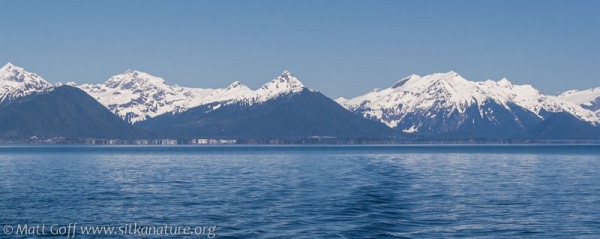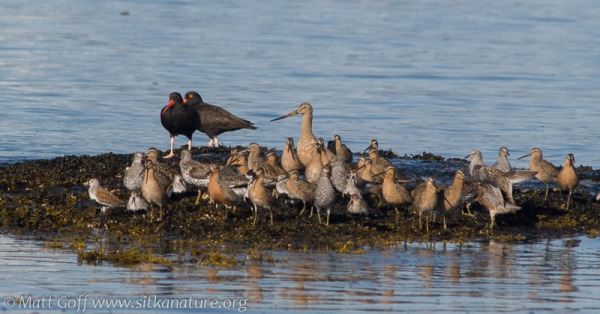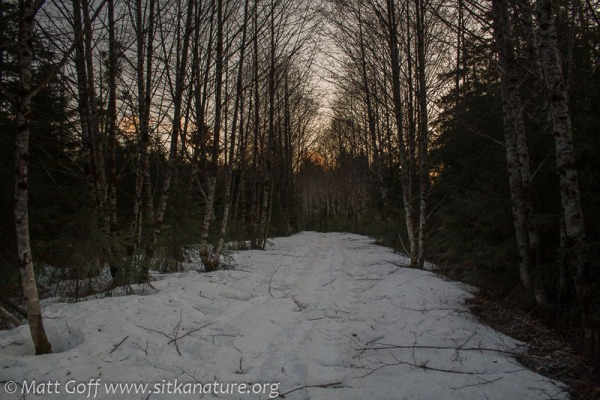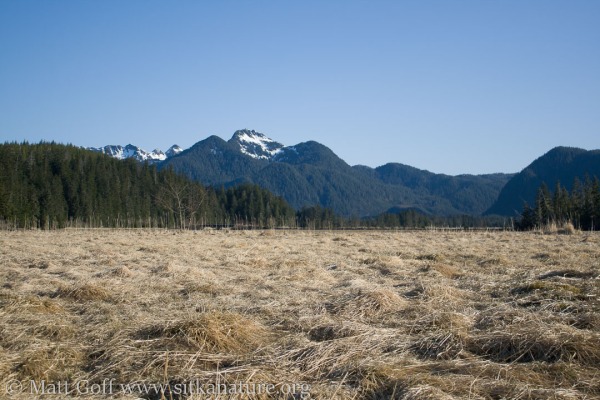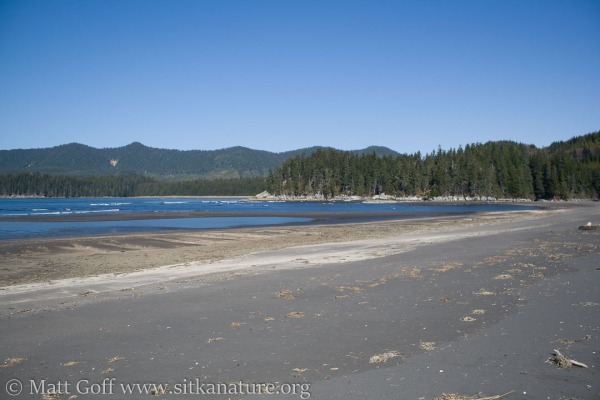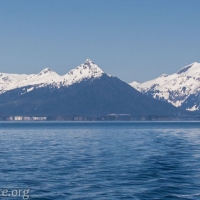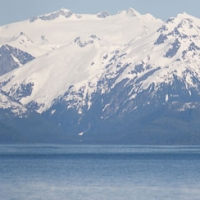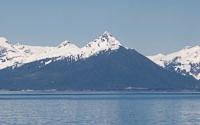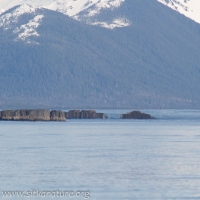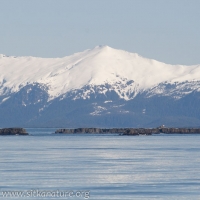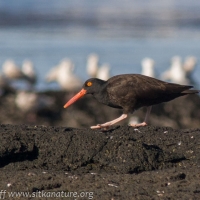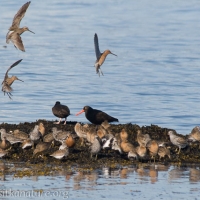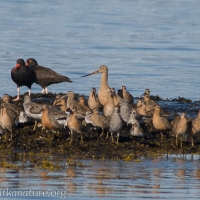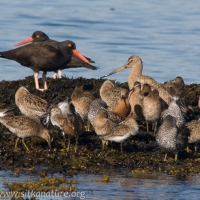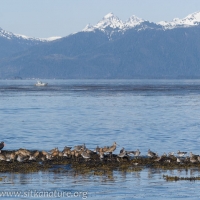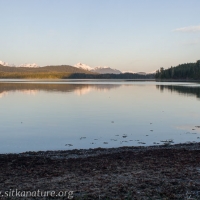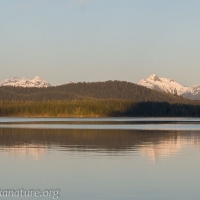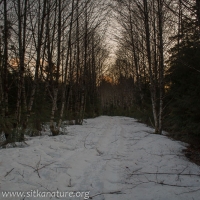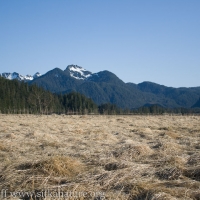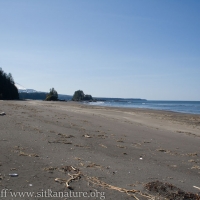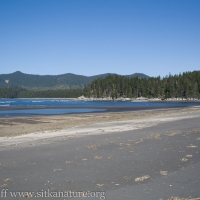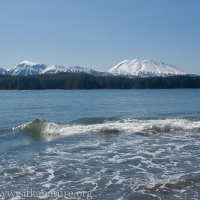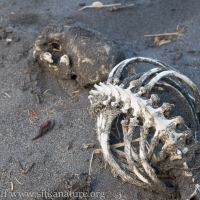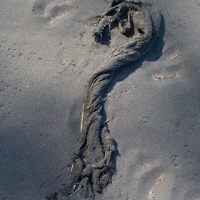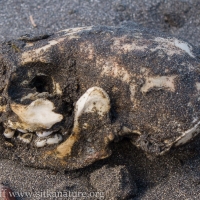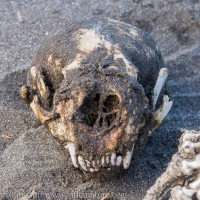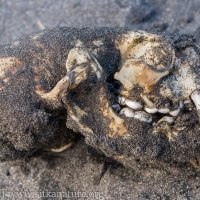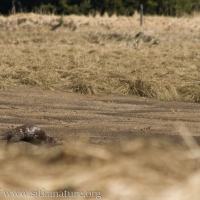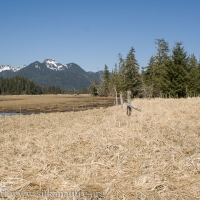I had never been to Shelikof and with a forecast for sunny and calm weather over the weekend, I thought it might be nice to make a trip out there and kayak back to town.
I was motivated in part by birds. 500 Pacific Loons had been reported on the sound, and Red Knots had been seen on some of the rocky islets.
I was running a bit late, and since I was getting a ride in a skiff, I did not try to pack everything carefully in my low volume skin-on-frame kayak (with its limited cargo space). Kitty had agreed to give me a ride to Mud Bay, and I planned to walk over on Friday evening, then start making my way back on Saturday, staying somewhere along the way Saturday night, and completing the trip on Sunday, when I was due back at midday.
We were on our way by 3pm Friday. The sound was glassy calm, so we took a side trip to Low Island to check out the shorebirds there.
It was my first trip to Low Island. Unfortunately, my camera got splashed when I slipped while wading to get a better look at some birds. It stopped working, so I took fewer photos than I might have liked to. Fortunately, it did start working again a bit later.
There are many shells washed up near the top of the island. We saw seals hauled out. Numbers of shorebirds were not high, but there was a nice mix, including Black Oystercatchers, and Red Knots.
The time we visiting the island meant I did not get dropped off at Mud Bay until shortly before sunset.
By the time I had unloaded, got my stuff together and started walking up the road, the sun was already setting.
I started hiking across. Despite the May date (with warm temperatures), there was still a fair bit of snow along the route.
Most of the route is an old logging road that gets a fair amount of four-wheeler traffic throughout the year when snow conditions allow. It was soon clear the snow had been an impediment to travel.
I did see a few tracks at the beginning, but they quickly disappeared, and it seemed like I was the first one to pass in some time.
Unfortunately for me, the snow was not solid enough to support my weight, and I found myself regularly punching through up to my shins or knees. Of course in the best of circumstances, this makes travel much more strenuous. However, I had also neglected to pack a pair of long pants, so the crunchy, crystalized snow was scraping and irritating my shins each time I punched through.
I had assumed the route finding would be straightforward, and despite the darkness (and the fact that I didn’t pack a light), I did not have concerns about following the old road.
My confidence was warranted on that account, I did easily stay on the road. However, I did not count on coming to a fork the road. With no recent tracks to guide me, and in the darkness each fork looking similarly maintained, I chose the left fork.
Slogging along the route, I tried to keep track of the stars to have a sense of which direction I was travelling. Along the way I heard what I thought might be the ocean waves breaking on a beach up ahead in the distance, but later suspect had actually been a waterfall. After an hour or so, I came to the conclusion that I had picked the wrong fork and made my way back again, and picked the other fork.
I had a small laptop with me with maps on it, and did ultimately check in with it, though found it not as helpful as I might have liked due to the many logging roads it showed (not all of which were actually maintained on the ground), and a lack of certainty about where exactly I was.
It was approaching midnight when I reached an open area at what I later learned was where the road came to Iris Meadows. I was not entirely sure where to go at this point, but there seemed to be only one main road, so I followed it.
It took me across an open area, and then began to wind its way up a hill, eventually turning away from the direction I knew I needed to go.
The route is supposed to be 7 miles across, which in good conditions should only take a 2-3 hours to walk. I figure I may have walked closer to 10 miles, and had been at it for about 5 hours when I decided I was done around 1am.
A heavier backpack than I’m used to, post holing in snow, and a side trip of maybe an hour or so, plus dehydration left me feeling exhausted. I stopped along the road at a spot that felt a little warmer. I pulled out the thin foam pad, fleece sleeping bag, and space blanket. I climbed in (sweaty clothes and all) to sleep as best I could.
Although the spot felt strangely warm I spent the next five hours of trying to arrange myself to keep from shivering and not have my legs cramp up while getting what sleep I could.
For better and worse, sunrise came fairly early, and after a short night which was mercifully not as cold as it could have been, I started back down the way I had come.
With the advantage of daylight, I saw that I had crossed part of Iris Meadows in the night. It was a chilly, but lovely early morning as I made my way back. Upon reaching the clearing area I had paused at late the previous night, I saw the trail for the main Shelikof Cabin.
It was then I realized that had I continued on the way I had been going, I would have ended up at North Beach, though I’m uncertain how much longer it would have taken me.
In full light I had no problem following the foot path to the main Shelikof Cabin.
As I suspected, the inconvenient trail conditions meant I had the whole place to myself.
The sun was up and the dark sand of the beach warmed up quickly.
I spent a couple of hours walking the beach and enjoying the warm sun, I may have even dozed off for a bit.
I’m sure I would have enjoyed it more were I not so exhausted.
As much as it would have been nice to spend the whole day, I knew it would take me at least a couple of hours to walk the road back, and then I had a long way to paddle beyond that.
Although route finding was not an issue and I could enjoy more of the scenery, in other ways, walking the road back in the heat of the day was a much less pleasant experience than walking it the previous night.
The temperature felt quite warm, and the added effort required to trudge through the snow had me sweating heavily. I tried to drink enough water, but in hindsight was clearly unsuccessful at that. The sun softened snow resulted in even more post holing. Between the snow and the road-side bushes that I walked through to avoid post-holing, the skin on my shins became very irritated.
I think it ended up taking me 3-4 hours to walk the 7 miles back to Mud Bay, and I arrived late in the afternoon.
The forecast had held up, and winds were calm, making for relatively easy paddling on smooth water.
I paddled through Port Krestof and out in to Hayward Strait. As I reached where it opens up to the sound near Brent’s Beach I looked across the 2 mile stretch of relatively exposed water, and saw nothing but a glassy surface.
I still had plenty of light to cross, but I felt terrible/ill (due in large part to being dehydrated, I think) and decided to paddle in to a little mini-cove on Krestof Island.
By the standards of most (sensible) people, I don’t think it was much of a place to camp, but I can be pretty minimalist. I built a fire on the beach and planned to just hunker down near it to stay warm while I slept.
I learned a lesson that night. Driftwood can crackle a lot. It was not so much the sound that got me, but the pieces of still hot burning wood that flew as part of the miniature explosion which made the crackling and popping sounds. These still carried enough heat to burn or melt materials, including the clothes I was wearing, the foam pad, and the space blanket.
I got what sleep that I could by the fire. In addition to the hot sparks requiring attention from time to time, my legs were so scraped up and irritated from the walking it was difficult to get comfortable. They were already sore, and then felt like they were burning when exposed to any heat from the fire.
The next morning when I set out, it looked okay. I don’t have a lot of kayaking experience, but what I saw looked like a bit of a riffle on the water. It was not glassy like last night, but didn’t look bad.
No sooner had I really started crossing than the wind picked up, and pretty soon there were what seemed like pretty sizable waves. They were probably actually about 1.5 ft, but were white-capping pretty easily and the wind was getting more intense. At that point it felt like there was nothing to do but keep going.
Fortunately my kayak is pretty seaworthy, in that it took the waves just fine. For me, paddling into the wind was tough, and I was very aware of my lack of experience. I was tired already, and making the pull across was tough, though in the end it only took about 20 minutes (much faster than I would have guessed).
Once across the main opening, I was able to duck behind a small island off of Crow Island and call Kitty to see if she could come get me. I paddled on and waited inside of Middle Island. The wind picked up further. As it turned out, I probably could have made it, but would have been more exhausted than I was already.
With Kitty’s help, I did make it back by my planned midday return time.
While the trip certainly had some nice aspects, there was plenty of unnecessary unpleasantness. Lessons (hopefully) learned.
My iNaturalist Observations for Day 1
My iNaturalist Observations for Day 2

